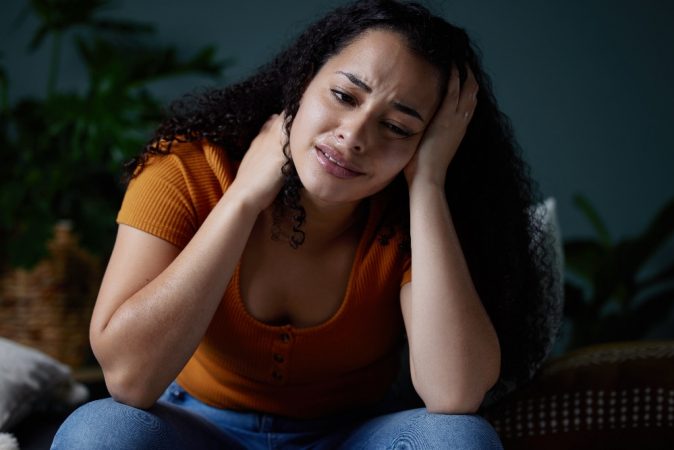In today’s fast-paced world, anxiety has become a silent companion to many, whispering worries and fears that can sometimes manifest in unexpected ways. Among these physical manifestations, muscle twitching often emerges as a puzzling symptom, leaving many to wonder about the connection between their mental health and these involuntary movements. This exploration seeks not just to answer whether anxiety can cause twitching, but also to understand the depths of this relationship, providing insights and strategies to those affected.
Understanding Anxiety
Anxiety is more than fleeting moments of worry or fear; it’s a pervasive condition that can significantly impact daily life. Characterized by constant, overwhelming dread without a clear cause, anxiety disorders can manifest in various forms, including generalized anxiety disorder (GAD), panic disorder, and social anxiety disorder, among others. Anxiety symptoms can be both mental and physical, ranging from feelings of unease to heart palpitations and fatigue. This complex condition stems from a combination of genetic, environmental, and psychological factors, leading to a heightened state of worry that can affect one’s ability to function in everyday situations.
What is Twitching?
Twitching refers to sudden, involuntary muscle movements or spasms that can occur in any part of the body. These spasms are often quick and can vary in intensity and frequency. While twitching is usually harmless and temporary, it can become persistent or bothersome for some individuals. Twitches are most commonly experienced in the eyelids, calves, and thumbs and are generally not a sign of a serious medical condition. They can be triggered by various factors, including stress, fatigue, caffeine, and nutrient deficiencies.
Different Kinds of Anxiety Twitching
Anxiety can lead to various kinds of twitching, each potentially linked to the intensity or nature of the anxiety experienced:
- Eyelid Twitching: Often one of the most noticeable forms, where the eyelid may twitch or spasm involuntarily. Eye twitching is frequently associated with stress, fatigue, or caffeine.
- Muscle Twitching in Limbs: Anxiety can cause twitching in the arms and legs, which may be sporadic or feel like a persistent quiver under the skin. This is typically related to the body’s heightened stress response and muscle tension.
- Facial Twitching: Stress and anxiety can also manifest as twitching around the mouth or other facial muscles, not uncommon during periods of high anxiety or stress.
- Generalized Twitching: For some, anxiety leads to widespread twitching across the body, which can be distressing and exacerbate worries about health.
The Connection Between Anxiety and Twitching
Anxiety and twitching are connected through the body’s physical response to stress and emotional distress. When an individual experiences anxiety, the body’s fight-or-flight response is activated, leading to an increase in stress hormones like adrenaline. This response prepares the body to face a perceived threat, resulting in heightened physical alertness and muscle readiness. Prolonged periods of anxiety can maintain this state of readiness, causing muscles to become tense and eventually twitch as a side effect of constant stress and nervous system stimulation. Therefore, twitching can be seen as a physical manifestation of the internal emotional turmoil caused by anxiety.
Anxiety can also lead to symptoms such as accelerated breathing, a condition that may significantly lower calcium levels in the bloodstream. This decrease in calcium can trigger various symptoms related to the nervous system, notably including muscle spasms and twitching. Twitching induced by anxiety signals that your body might be experiencing an imbalance.
How Anxiety Triggers Twitching
The mechanism behind anxiety-induced twitching lies in the body’s nervous system response to stress. Anxiety can lead to muscle tension as part of the body’s natural defense mechanism. Over time, this sustained muscle tension can result in fatigue and localized muscle spasms, or twitching. Additionally, anxiety can disrupt sleep patterns, leading to fatigue, which further exacerbates the likelihood of twitching. The combination of muscle tension, increased stress hormones, and sleep disturbances creates a cycle where anxiety perpetuates physical symptoms, including twitching, thereby highlighting the intricate link between mental health and physical well-being.
Preventive Measures That May Help to Stop Anxiety Twitching
In navigating the complexities of anxiety-induced twitching, understanding preventive measures is key to mitigating and possibly stopping this unsettling symptom. Prevention focuses on managing anxiety levels, thereby reducing the likelihood of twitching as a physical manifestation. Here are strategies that can play a pivotal role in prevention:
- Lifestyle Modifications: A holistic approach to lifestyle can significantly impact anxiety levels. Regular physical activity, a balanced diet rich in nutrients, and sufficient sleep are foundational elements. Exercise, in particular, is a natural anxiety reliever that improves physical and mental health, helping to ease muscle tension and reduce stress.
- Stress Management Techniques: Developing a toolbox of stress management techniques is crucial. Techniques such as deep breathing exercises, meditation, and yoga can help calm the mind and body, reducing the immediate physiological effects of stress and anxiety. Implementing these practices regularly can help maintain a state of relaxation, lowering the chances of twitching.
- Mindfulness and Relaxation: Mindfulness encourages living in the present moment and accepting it without judgment, which can significantly reduce anxiety. Mindfulness-based stress reduction (MBSR) and other relaxation techniques can decrease muscle tension and prevent twitching.
- Limit Stimulants: Reducing the intake of stimulants such as caffeine and nicotine can help manage anxiety levels. These substances can exacerbate anxiety symptoms, including twitching, by increasing heart rate and tension.
- Seek Social Support: A strong support network can provide comfort and reduce stress. Talking with friends, family, or members of support groups can offer relief from anxiety and its physical symptoms.
- Professional Counseling: Engaging in counseling or cognitive-behavioral therapy (CBT) with a mental health professional can be effective in addressing the root causes of anxiety. These therapies can teach coping strategies to manage anxiety proactively, reducing the likelihood of twitching.
How is Anxiety Twitching Diagnosed?
Diagnosing anxiety-induced twitching involves a multifaceted approach, primarily because twitching can be a symptom of various conditions aside from anxiety. A healthcare provider will typically follow these steps to diagnose:
- Medical History and Symptoms Review: The first step involves discussing your medical history, symptoms, and the contexts in which twitching occurs. Understanding the relationship between anxiety episodes and twitching episodes can provide initial clues.
- Physical Examination: A physical exam may be conducted to observe the twitching and assess overall muscle health and nerve function. This can help rule out physical causes unrelated to anxiety.
- Neurological Tests: In some cases, neurological tests might be performed to rule out neurological disorders. These tests can include nerve conduction studies, electromyography (EMG), or magnetic resonance imaging (MRI) scans.
- Psychological Evaluation: Since the focus is on anxiety-induced twitching, a thorough psychological evaluation is crucial. This might involve questionnaires or interviews based on diagnostic criteria for anxiety disorders.
- Rule Out Other Conditions: It’s important to exclude other potential causes of twitching, such as nutritional deficiencies, drug side effects, or other neurological conditions. Blood tests might be conducted to check for imbalances that could contribute to twitching.
- Diagnosis of Anxiety Disorder: If other causes are ruled out and a significant correlation between anxiety and twitching is established, the diagnosis may point towards an anxiety disorder being the underlying cause of the twitching.
Start Your Healing Journey
the connection between anxiety and twitching is a tangible representation of how psychological stress can manifest physically, affecting our bodies in unexpected ways. Understanding the nature of anxiety, recognizing the different kinds of twitching it can cause, and acknowledging the physiological mechanisms behind these involuntary movements provide crucial insights into managing this condition.
If you or a loved one are struggling with anxiety, get in touch with Safe and Sound Treatment. Our treatment facility is dedicated to providing individuals a positive environment to overcome the challenges of anxiety.
FAQs
Yes, anxiety can cause twitching in various parts of the body. While it’s more common in the eyelids, arms, and legs, anxiety-induced muscle spasms can potentially affect any muscle group.
Yes, twitching is a relatively common symptom among individuals experiencing high levels of anxiety, especially when the anxiety is persistent or severe.
Consulting with a healthcare professional is crucial for an accurate diagnosis. They can help differentiate between twitching caused by anxiety and symptoms linked to other medical conditions through a comprehensive medical history, physical examination, and possibly diagnostic tests.
Long-term anxiety can lead to a range of physical health issues, including chronic muscle tension, headaches, digestive issues, and a weakened immune system, among others.
Yes, effectively managing anxiety can help reduce or eliminate twitching. Treatments like therapy, medication, and lifestyle changes can significantly alleviate the symptoms of anxiety, thereby reducing the incidence of twitching.













